Abstract
In recent host-guest studies, the helix-forming tendencies of amino acid residues have been quantified by three groups, each obtaining similar results [Padmanabhan, S., Marqusee, S., Ridgeway, T., Laue, T. M. & Baldwin, R. L. (1990) Nature (London) 344, 268-270; O'Neil, K. T. & DeGrado, W. F. (1990) Science 250, 646-651; Lyu, P. C., Liff, M. I., Marky, L. A. & Kallenbach, N. R. (1990) Science 250, 669-673]. Here, we explore the hypothesis that these measured helix-forming propensities are due primarily to conformational restrictions imposed upon residue side chains by the helix itself. This proposition is tested by calculating the extent to which the bulky helix backbone "freezes out" available degrees of freedom in helix side chains. Specifically, for a series of apolar residues, the difference in configurational entropy, delta S, between each side chain in the unfolded state and in the alpha-helical state is obtained from a simple Monte Carlo calculation. These computed entropy differences are then compared with the experimentally determined values. Measured and calculated values are found to be in close agreement for naturally occurring amino acids and in total disagreement for non-natural amino acids. In the calculation, delta S(Ala) = 0. The rank order of entropy loss for the series of natural apolar side chains under consideration is Ala less than Leu less than Trp less than Met less than Phe less than Ile less than Tyr less than Val. Among these, none favor helix formation; Ala is neutral, and all remaining residues are unfavorable to varying degrees. Thus, applied to side chains, the term "helix preference" is a misnomer. While side chain-side chain interactions may modulate stability in some instances, our results indicate that the drive to form helices must originate in the backbone, consistent with Pauling's view of four decades ago [Pauling, L., Corey, R. B. & Branson, H. R. (1951) Proc. Natl. Acad. Sci. USA 37, 205-210].
Full text
PDF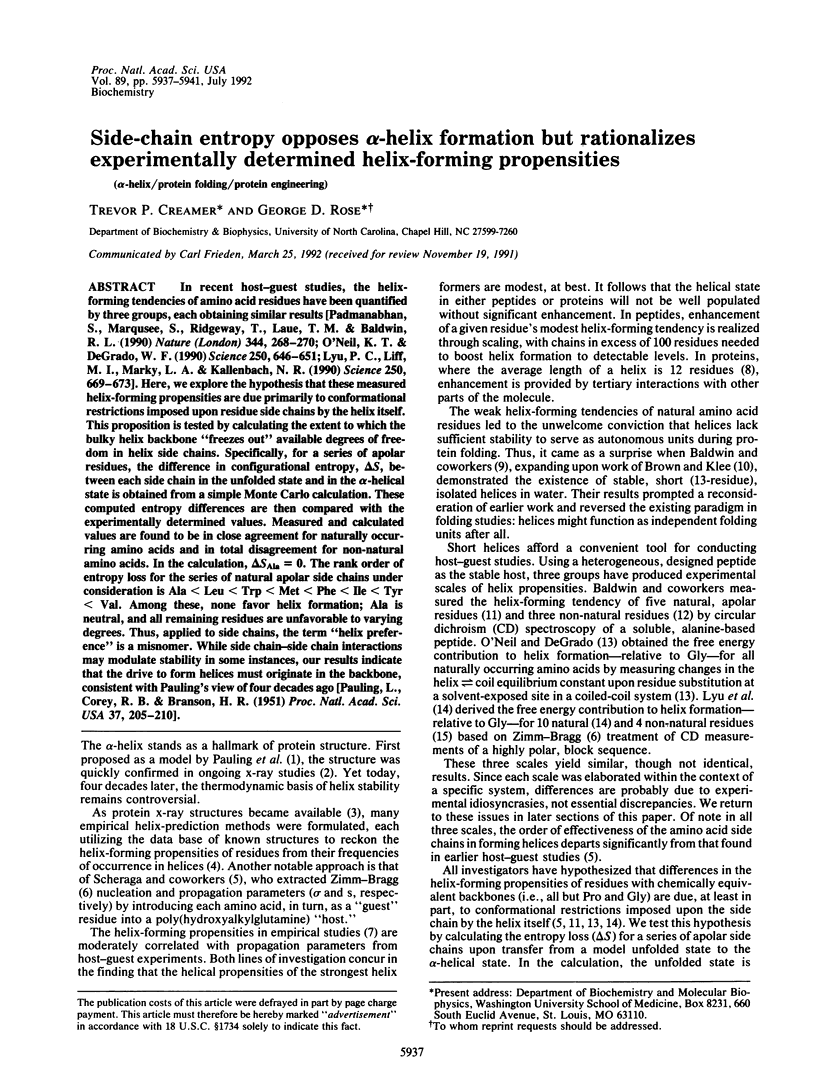
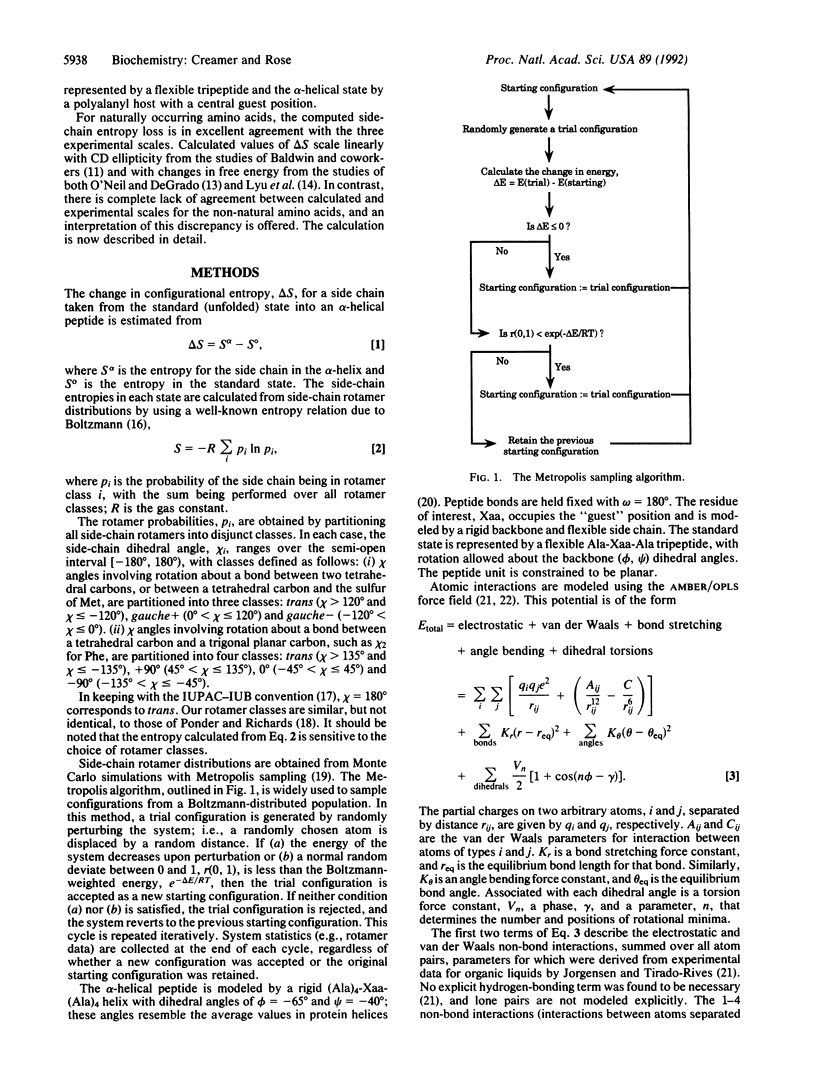
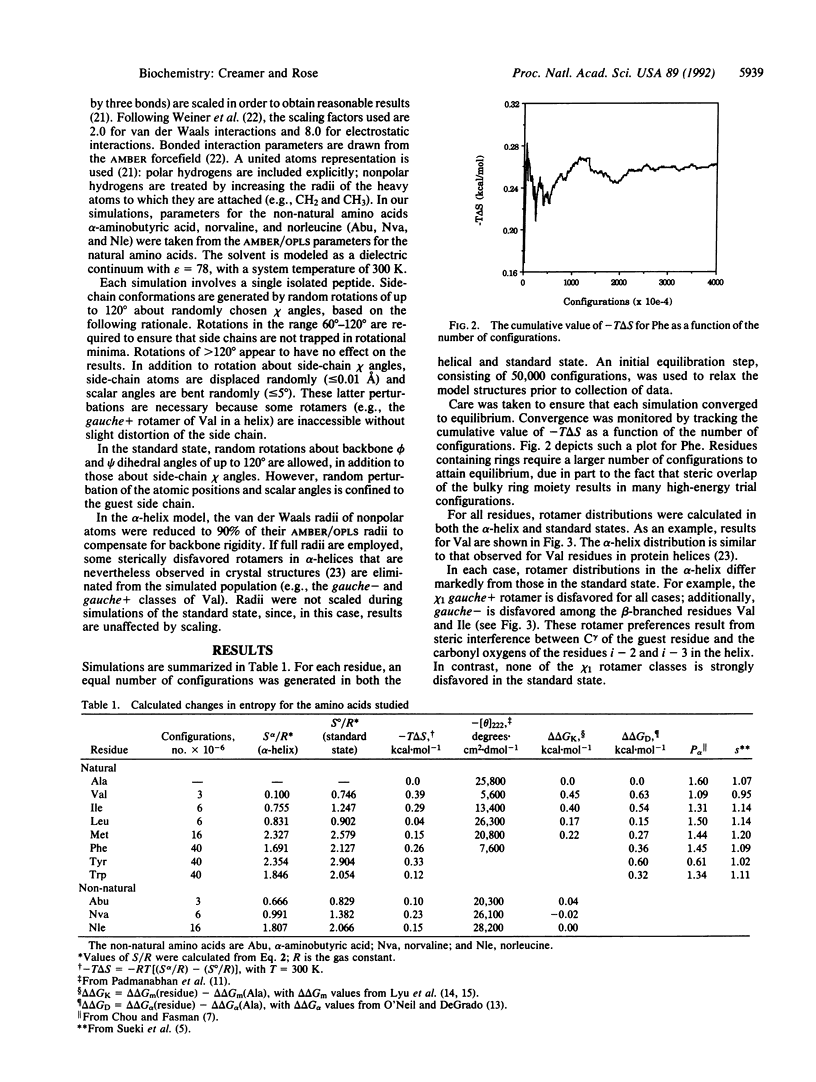
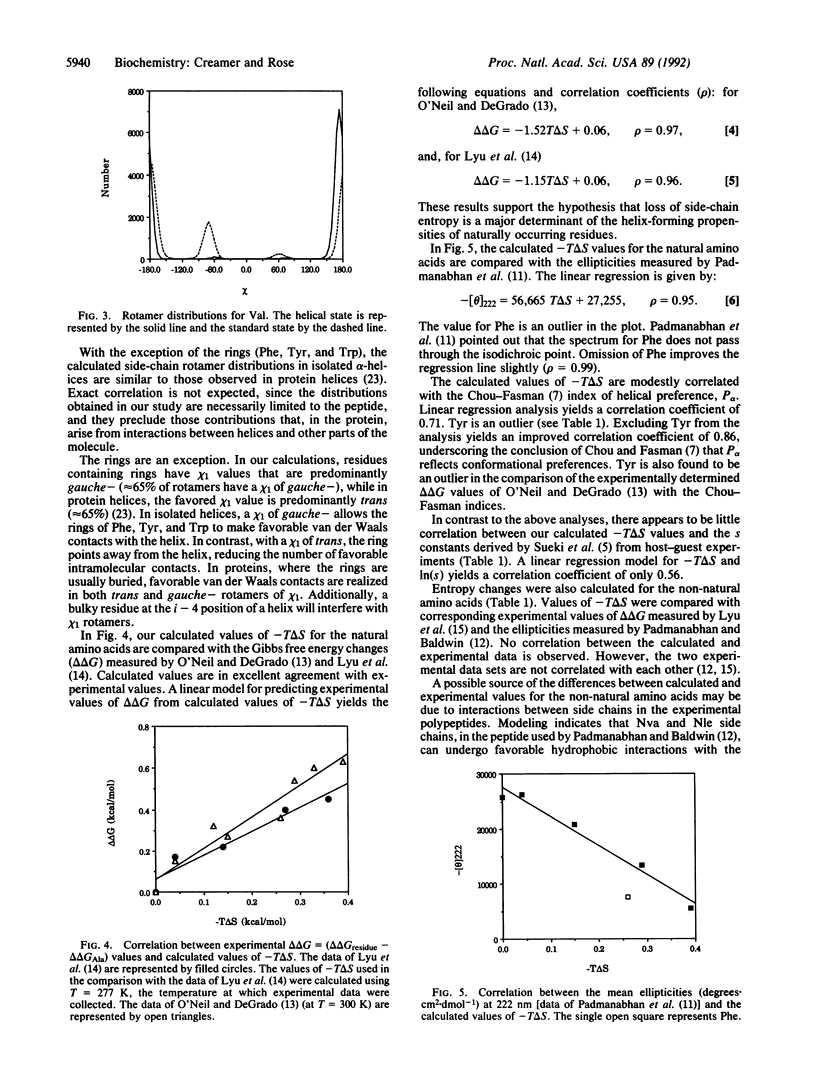
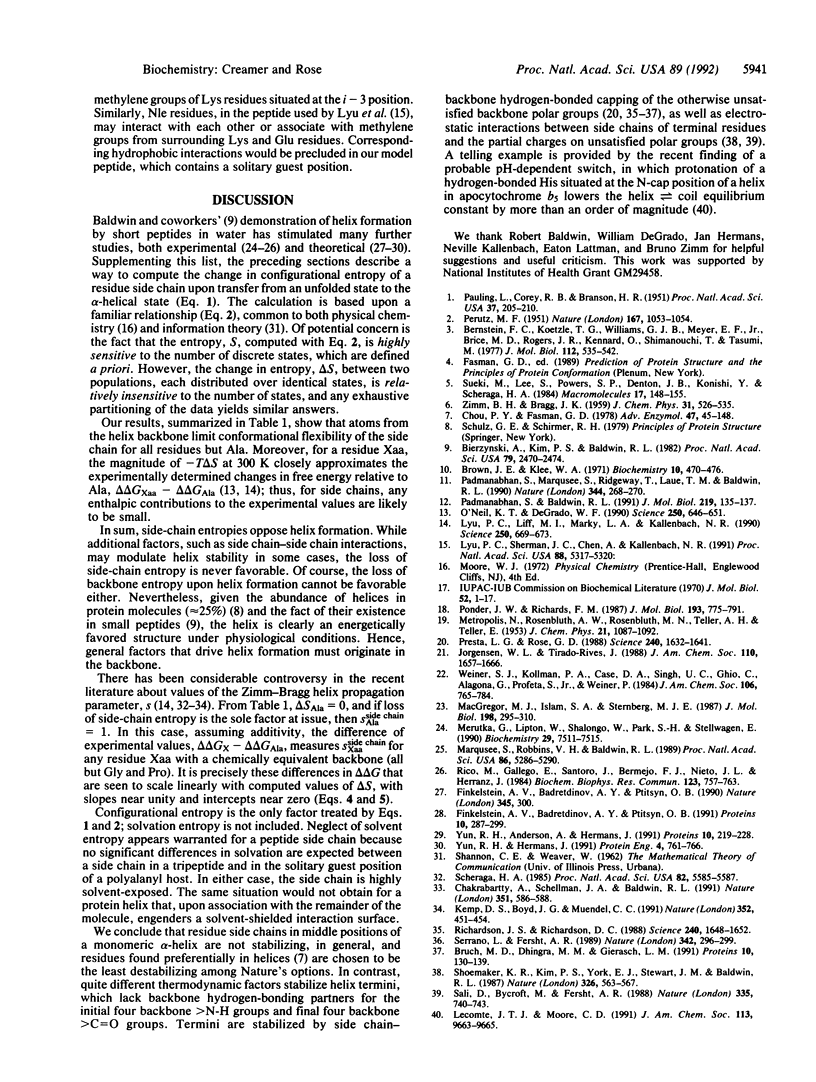
Selected References
These references are in PubMed. This may not be the complete list of references from this article.
- Bernstein F. C., Koetzle T. F., Williams G. J., Meyer E. F., Jr, Brice M. D., Rodgers J. R., Kennard O., Shimanouchi T., Tasumi M. The Protein Data Bank: a computer-based archival file for macromolecular structures. J Mol Biol. 1977 May 25;112(3):535–542. doi: 10.1016/s0022-2836(77)80200-3. [DOI] [PubMed] [Google Scholar]
- Bierzynski A., Kim P. S., Baldwin R. L. A salt bridge stabilizes the helix formed by isolated C-peptide of RNase A. Proc Natl Acad Sci U S A. 1982 Apr;79(8):2470–2474. doi: 10.1073/pnas.79.8.2470. [DOI] [PMC free article] [PubMed] [Google Scholar]
- Brown J. E., Klee W. A. Helix-coil transition of the isolated amino terminus of ribonuclease. Biochemistry. 1971 Feb 2;10(3):470–476. doi: 10.1021/bi00779a019. [DOI] [PubMed] [Google Scholar]
- Bruch M. D., Dhingra M. M., Gierasch L. M. Side chain-backbone hydrogen bonding contributes to helix stability in peptides derived from an alpha-helical region of carboxypeptidase A. Proteins. 1991;10(2):130–139. doi: 10.1002/prot.340100206. [DOI] [PubMed] [Google Scholar]
- Chakrabartty A., Schellman J. A., Baldwin R. L. Large differences in the helix propensities of alanine and glycine. Nature. 1991 Jun 13;351(6327):586–588. doi: 10.1038/351586a0. [DOI] [PubMed] [Google Scholar]
- Chou P. Y., Fasman G. D. Prediction of the secondary structure of proteins from their amino acid sequence. Adv Enzymol Relat Areas Mol Biol. 1978;47:45–148. doi: 10.1002/9780470122921.ch2. [DOI] [PubMed] [Google Scholar]
- Finkelstein A. V., Badretdinov A. Y., Ptitsyn O. B. Physical reasons for secondary structure stability: alpha-helices in short peptides. Proteins. 1991;10(4):287–299. doi: 10.1002/prot.340100403. [DOI] [PubMed] [Google Scholar]
- Kemp D. S., Boyd J. G., Muendel C. C. The helical s constant for alanine in water derived from template-nucleated helices. Nature. 1991 Aug 1;352(6334):451–454. doi: 10.1038/352451a0. [DOI] [PubMed] [Google Scholar]
- Lyu P. C., Liff M. I., Marky L. A., Kallenbach N. R. Side chain contributions to the stability of alpha-helical structure in peptides. Science. 1990 Nov 2;250(4981):669–673. doi: 10.1126/science.2237416. [DOI] [PubMed] [Google Scholar]
- Lyu P. C., Sherman J. C., Chen A., Kallenbach N. R. Alpha-helix stabilization by natural and unnatural amino acids with alkyl side chains. Proc Natl Acad Sci U S A. 1991 Jun 15;88(12):5317–5320. doi: 10.1073/pnas.88.12.5317. [DOI] [PMC free article] [PubMed] [Google Scholar]
- Marqusee S., Robbins V. H., Baldwin R. L. Unusually stable helix formation in short alanine-based peptides. Proc Natl Acad Sci U S A. 1989 Jul;86(14):5286–5290. doi: 10.1073/pnas.86.14.5286. [DOI] [PMC free article] [PubMed] [Google Scholar]
- McGregor M. J., Islam S. A., Sternberg M. J. Analysis of the relationship between side-chain conformation and secondary structure in globular proteins. J Mol Biol. 1987 Nov 20;198(2):295–310. doi: 10.1016/0022-2836(87)90314-7. [DOI] [PubMed] [Google Scholar]
- Merutka G., Lipton W., Shalongo W., Park S. H., Stellwagen E. Effect of central-residue replacements on the helical stability of a monomeric peptide. Biochemistry. 1990 Aug 14;29(32):7511–7515. doi: 10.1021/bi00484a021. [DOI] [PubMed] [Google Scholar]
- O'Neil K. T., DeGrado W. F. A thermodynamic scale for the helix-forming tendencies of the commonly occurring amino acids. Science. 1990 Nov 2;250(4981):646–651. doi: 10.1126/science.2237415. [DOI] [PubMed] [Google Scholar]
- PAULING L., COREY R. B., BRANSON H. R. The structure of proteins; two hydrogen-bonded helical configurations of the polypeptide chain. Proc Natl Acad Sci U S A. 1951 Apr;37(4):205–211. doi: 10.1073/pnas.37.4.205. [DOI] [PMC free article] [PubMed] [Google Scholar]
- PERUTZ M. F. New x-ray evidence on the configuration of polypeptide chains. Nature. 1951 Jun 30;167(4261):1053–1054. doi: 10.1038/1671053a0. [DOI] [PubMed] [Google Scholar]
- Padmanabhan S., Baldwin R. L. Straight-chain non-polar amino acids are good helix-formers in water. J Mol Biol. 1991 May 20;219(2):135–137. doi: 10.1016/0022-2836(91)90553-i. [DOI] [PubMed] [Google Scholar]
- Padmanabhan S., Marqusee S., Ridgeway T., Laue T. M., Baldwin R. L. Relative helix-forming tendencies of nonpolar amino acids. Nature. 1990 Mar 15;344(6263):268–270. doi: 10.1038/344268a0. [DOI] [PubMed] [Google Scholar]
- Ponder J. W., Richards F. M. Tertiary templates for proteins. Use of packing criteria in the enumeration of allowed sequences for different structural classes. J Mol Biol. 1987 Feb 20;193(4):775–791. doi: 10.1016/0022-2836(87)90358-5. [DOI] [PubMed] [Google Scholar]
- Presta L. G., Rose G. D. Helix signals in proteins. Science. 1988 Jun 17;240(4859):1632–1641. doi: 10.1126/science.2837824. [DOI] [PubMed] [Google Scholar]
- Richardson J. S., Richardson D. C. Amino acid preferences for specific locations at the ends of alpha helices. Science. 1988 Jun 17;240(4859):1648–1652. doi: 10.1126/science.3381086. [DOI] [PubMed] [Google Scholar]
- Rico M., Gallego E., Santoro J., Bermejo F. J., Nieto J. L., Herranz J. On the fundamental role of the Glu 2- ... Arg 10+ salt bridge in the folding of isolated ribonuclease A S-peptide. Biochem Biophys Res Commun. 1984 Sep 17;123(2):757–763. doi: 10.1016/0006-291x(84)90294-8. [DOI] [PubMed] [Google Scholar]
- Sali D., Bycroft M., Fersht A. R. Stabilization of protein structure by interaction of alpha-helix dipole with a charged side chain. Nature. 1988 Oct 20;335(6192):740–743. doi: 10.1038/335740a0. [DOI] [PubMed] [Google Scholar]
- Scheraga H. A. Effect of side chain-backbone electrostatic interactions on the stability of alpha-helices. Proc Natl Acad Sci U S A. 1985 Sep;82(17):5585–5587. doi: 10.1073/pnas.82.17.5585. [DOI] [PMC free article] [PubMed] [Google Scholar]
- Serrano L., Fersht A. R. Capping and alpha-helix stability. Nature. 1989 Nov 16;342(6247):296–299. doi: 10.1038/342296a0. [DOI] [PubMed] [Google Scholar]
- Shoemaker K. R., Kim P. S., York E. J., Stewart J. M., Baldwin R. L. Tests of the helix dipole model for stabilization of alpha-helices. Nature. 1987 Apr 9;326(6113):563–567. doi: 10.1038/326563a0. [DOI] [PubMed] [Google Scholar]
- Yun R. H., Anderson A., Hermans J. Proline in alpha-helix: stability and conformation studied by dynamics simulation. Proteins. 1991;10(3):219–228. doi: 10.1002/prot.340100306. [DOI] [PubMed] [Google Scholar]
- Yun R. H., Hermans J. Conformational equilibria of valine studied by dynamics simulation. Protein Eng. 1991 Oct;4(7):761–766. doi: 10.1093/protein/4.7.761. [DOI] [PubMed] [Google Scholar]


